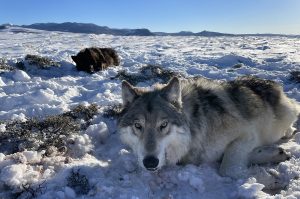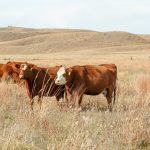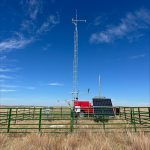As a third wolf reintroduction approaches, ranchers fear CPW is unprepared to deal with the worst
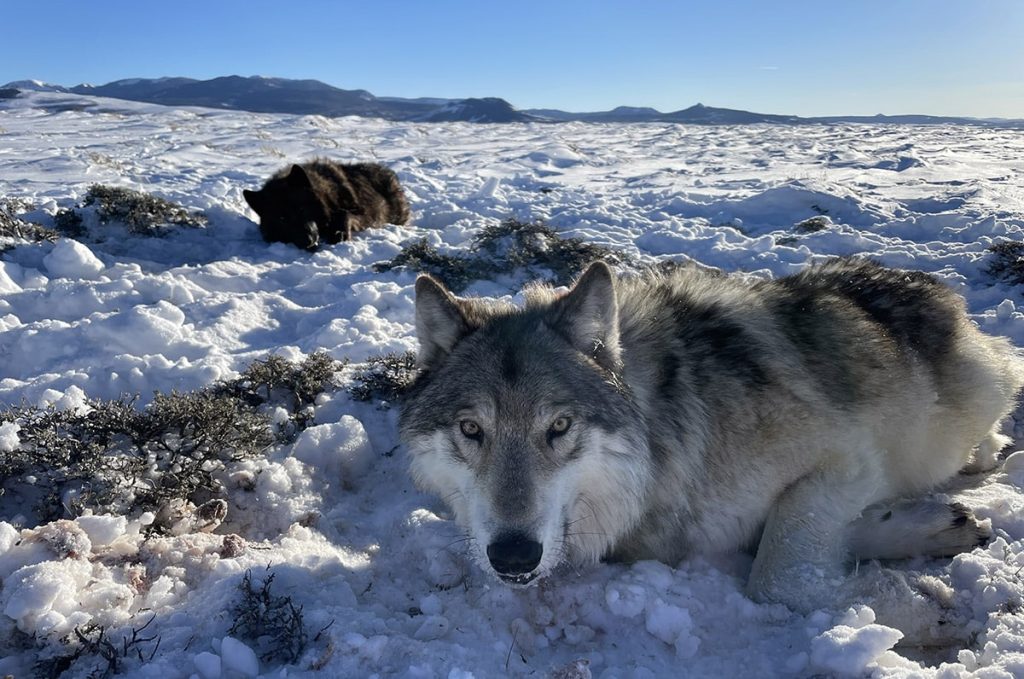
Spann2-RFP-111025
On a chilly October night, rancher Ken Spann watched over his family’s freshly weaned steer calves, a routine practice to keep young calves from breaking through fences in search of their mothers. Soon, a new threat will join the mix — wolves.
Gunnison County is expected to host the December-January release of 15 wolves under Proposition 114 passed in 2020, which authorized wolf reintroduction. Colorado’s Wolf Restoration and Management Plan lists the Highway 50 corridor between Monarch Pass and Montrose, home to numerous cattle ranches, as its southern release area.
Spann’s family ranching business is based in Gunnison County, and like many stock producers, he fears Colorado Parks and Wildlife is unprepared for wolves arriving on the landscape in December, despite state law requiring CPW to help prevent and mitigate conflicts.
“I don’t think Colorado Parks and Wildlife is adequately ready for the expansion and introduction of wolves into the Gunnison Basin,” Spann said. “That’s why we want a pause. Not a stop. We just want a pause.”
This will be the third reintroduction since 2023 in a program that both ranchers and wolf advocates say has been mismanaged. Originally projected to cost $800,000 annually, the 2024-2025 budget now exceeds $3 million. With 37 confirmed depredations and more than $600,000 paid in claims, generational cattle ranches expect the worst. A Gunnison County calf, killed May 6, was among the losses.
Ten wolves have died as well, with the six-month survival rate of British Columbia wolves released in January 2025 dropping to 67%. The plan calls for a protocol review if the survival rate falls below 70% and allows suspension “at any time until likely cause(s) of problems are identified, and acceptable solutions can be implemented to resolve the problems.”
Additionally, a recent letter from the U.S. Fish and Wildlife Service could further delay the December release, directing CPW to source wolves from Northern Rocky Mountain states, not Canada — agreements Colorado has had difficulty securing.
A citizen petition initiated by the Gunnison County Stockgrowers Association, citing state statute and asking for a pause in reintroduction for one year, has been submitted to the Colorado Parks and Wildlife Commission. Previous requests have failed, and time is running out.
The commission meets Nov. 13-14 in Sterling, Colo., but a review of the petition is not on the finalized agenda.
PETITION FOR A PAUSE
On Sept. 5, Gunnison County Stockgrowers’ Association submitted a petition to the CPW Commission signed by 28 other organizations and governmental groups, including county commissioners from eight different counties. The petition cites Colorado Revised Statute 33-2-105.8, which requires “… wolf restoration be designed to resolve conflicts with persons engaged in farming and ranching….” The petition notes that wolf depredations underscore that CPW lacks to ability to prevent and resolve those conflicts. It also questions the sufficient funding of the program and says that there is a perception CPW is being pressured to deny livestock claims.
“More wolves should not be imported to Colorado, at great expense, until the division has the funding, staffing and policies in place to effectively manage wolves in Colorado,” the petition concludes. “Robust and effective front-end management is also fiscally prudent, as it will minimize the number of compensation claims the Division pays.”
The petition asks that the delay continue until at least Nov. 16, 2026.
Gunnison County Commissioners did not sign the petition, a noticeable absence among the counties that did sign.
In a written statement, Gunnison County Commissioners said they previously took formal action in a four-page letter to CPW supporting the Gunnison Stockgrowers. The letter, dated Aug. 19, asked that CPW follow the plan for wolf reintroduction, including proper preparation and resources, and then asked for a pause in the program if the state was unable to do so.
However, the letter was not submitted in the form of a petition requiring the “issuance, amendment, or repeal of any state rule,” by the commission.
The commissioners went on to say their “strategic approach” would be to work with CPW leadership to create an environment where the agency would be more responsive to local needs and concerns.
Stockgrowers President Andy Spann and the son of Ken Spann said the association and its members will continue to be engaged in the wolf reintroduction both now and in the future, no matter the outcome of the petition.
“GCSA will continue to advocate for its members as we move forward,” he said.
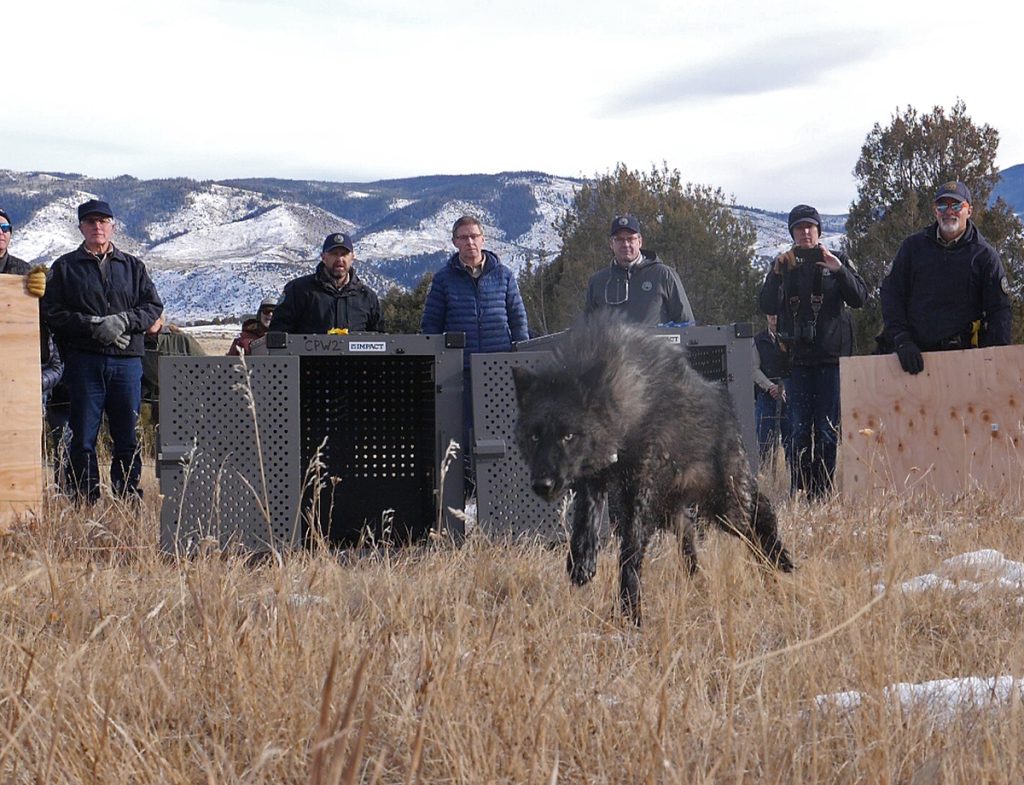
ARE THERE ENOUGH RESOURCES?
On Oct. 20, CPW Director Jeff Davis met with Gunnison County livestock producers to discuss the upcoming reintroduction. Those who attended the meeting said they were told 8 miles of fladry —fencing material that scares predators — was being relocated to Gunnison, and the southern release area would have 10 range riders funded seasonally, with two in Gunnison, from May through October. This did little to comfort the ranchers present for the meeting.
Calving season begins in the Gunnison Valley in early March, two months before the presence of range riders, and the stored fladry in Gunnison is only enough to enclose eight 40-acre parcels of land, costing $2,900 per parcel. There are almost 228,000 acres of agricultural land in the county and approximately 50 ranches.
CPW spokesman Luke Perkins said the agency was supplying several conflict minimization resource caches to be deployed on an as-needed basis. He did not specify amounts, but said Gunnison is currently building up their cache, including fladry. Perkins said three Wildlife Damage Specialists based in the southwest region would help in investigating wolf depredations.
Eleven range riders had been seasonally employed in northwestern Colorado (those contracts ended in October), Perkins continued, and CPW was currently building its 2026 program with an expanded number of riders. He said range riders were not contracted earlier in May because typically calving operations occurred at times of year when livestock are “more closely associated with human presence.”
Despite this, Kathleen Curry, who ranches with her husband, Greg Peterson, east of Gunnison, has concerns. CPW, she said, wants ranchers to practice carcass management to prevent attracting wolves, but offers no options for game animals killed on highways that are also a lure.
Denning activity, she said, starts in March, coinciding with calving season, and range riders beginning in March, rather than May, could help mitigate this activity too close to livestock.
“I am really worried about whether we will be able to discourage wolves from locating their dens near our cattle,” she said. “We saw the mismanagement that led to unnecessary deaths of cattle north of us, and we really don’t want to repeat that.”
Curry said she sincerely hopes that the commission will support the citizen petition to delay the planned wolf release because it will allow the agency and producers to prepare, as required by the reintroduction plan.
THINKING IT THROUGH AT SCALE
Middle Park Stockgrowers Association President Tim Ritschard said his Grand County organization has been sharing information with Gunnison ranchers. Grand County was the first wolf release site in 2023. The pack was eventually removed and then relocated due to depredations.
Ritschard recommended that the ranchers set up trail cameras and secure a veterinarian to examine depredations in addition to CPW officials, at a cost only to the ranchers. He said communication between ranchers will be key after wolves are on the ground.
“When one producer is affected, we are all affected,” he said. “We have to stick together and help each other.”
Perhaps that is the greatest worry for Gunnison County ranchers — not the next two years, but the impact on generations beyond. In addition to depredations, the threat of wolves can reduce the number of calves produced and impact body weight gain. For a producer that survives years that are negative in the cattle business, a 10% drop in productivity is critical, making it less likely that ranch stays in business.
Ken Spann believes CPW planning has not been thought through to scale, such as over the next decade. Planning he said should include large repeating depredation claims, impacts to the big game populations and hunting, which impacts CPW license revenue.
Ultimately, he said, it will be additional and so far, uncompensated labor of ranchers, already working long hours, that will fill the gaps in non-lethal mitigation efforts. In July, GCSA presented CPW with a detailed estimate of wolf-reintroduction mitigating costs to ranchers in the Gunnison Basin totaling $3.2 million. The wildlife commission has not responded to those estimates.
“The success of this program and the survival of our ranches is going to rest on the backs of the ranch families of western Colorado,” said Spann. “No one is paying them for the extra labor it takes. That’s where the real cost is.”

